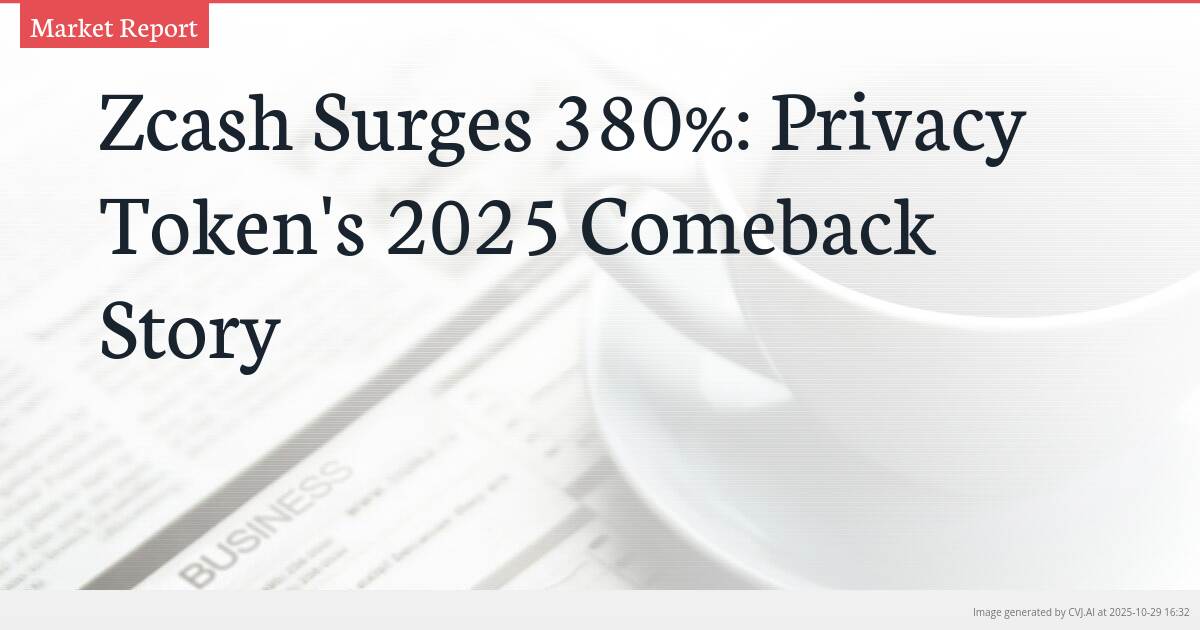This summary text is fully AI-generated and may therefore contain errors or be incomplete.
Introduction
Zcash, the once-forgotten privacy cryptocurrency, has staged a stunning 380% rally in 2025, reaching a three-year high of $370 and reclaiming its position among the top 25 digital assets with a $5.8 billion market capitalization. This remarkable resurgence represents more than mere speculation—it signals a fundamental reassessment of financial privacy in an era of increasing digital surveillance and regulatory scrutiny.
Key Points
- Zcash's 380% monthly surge propelled it back into top 25 cryptocurrencies with $5.8B market cap, marking its first major rally since 2021
- The comeback is fueled by technical upgrades in zero-knowledge proofs and growing concerns about financial surveillance from EU MiCA and UK Digital ID initiatives
- Despite trader misconceptions about a 2025 halving, the real catalysts include developer activity growth, exchange integrations, and endorsement from industry veterans like Arthur Hayes
From Cypherpunk Relic to Market Darling
For years, Zcash existed as little more than a historical footnote in the cryptocurrency landscape, overshadowed by the rise of AI tokens, restaking narratives, and layer-2 rollups. Launched in 2016 as a Bitcoin fork, Zcash maintained Bitcoin’s core deflationary design—capped supply, proof-of-work consensus, and periodic halvings—while introducing a revolutionary innovation: zero-knowledge proofs. This technology allowed users to verify transactions without revealing sender, receiver, or amount, creating what many considered true digital cash.
The project’s fortunes have dramatically reversed in recent weeks. According to CryptoSlate data, ZEC surged more than 380% in the past month, hitting $370 before settling around $340. This rally has lifted Zcash from obscurity back into the top 25 cryptocurrencies by market capitalization. Mert Mumtaz, CEO of Helius Labs, captured the sentiment perfectly: “Calling ZEC ‘encrypted bitcoin’ makes sense, in that it has the same tokenomics and SoV appeal but is private.”
The Privacy Renaissance in a Surveillance Era
Zcash’s resurgence coincides with growing global financial surveillance. The United Kingdom’s push for Digital IDs, the European Union’s MiCA privacy provisions, and increasing adoption of AI-based transaction tracing have reignited debates about financial privacy in programmable economies. This regulatory tension has transformed into market opportunity, with investors rotating into “ideological plays” like Zcash as Bitcoin and Ethereum trade sideways.
The privacy narrative has found powerful advocates. BitMEX co-founder Arthur Hayes has predicted ZEC could reach $10,000, while Digital Currency Group founder Barry Silbert has repeatedly amplified Zcash-related updates on social media platform X. Their endorsements have helped reframe ZEC’s rally as more than speculation—positioning it as a symbolic return of privacy to a market dominated by compliance narratives and centralized infrastructure.
Google search activity for “Zcash” has reached its highest level in five years, matching interest last seen during the 2021 bull cycle. Historical data suggests such retail attention often coincides with early phases of broader rallies, indicating this momentum may have room to run.
Technical Progress Versus Market Misconceptions
Part of Zcash’s recent excitement stems from a widespread misconception. Many traders cited an upcoming halving event in November 2025 as a key bullish driver, but crypto analytics platform Coincodex has clarified this is incorrect. The last Zcash halving occurred in November 2024, with the next not scheduled until late 2028.
Despite the timing error, scarcity remains central to Zcash’s identity. Like Bitcoin, it halves miner rewards every four years to control inflation and ensure predictable issuance. The narrative of limited supply has reinforced ZEC’s repositioning as a scarce, ideological asset in a market craving conviction.
Beyond halving myths, developers point to genuine technical progress as the real catalyst. The project recently released a public alpha of a new zero-knowledge architecture aimed at improving shielded transaction performance and wallet accessibility. This development has reignited enthusiasm among privacy researchers who view Zcash as a living laboratory for applied cryptography.
Sustainability Challenges and Long-Term Prospects
The sustainability of ZEC’s surge remains uncertain despite the impressive price action. Liquidity remains thin relative to major cryptocurrencies, and many exchanges still restrict shielded transactions. Institutional investors, constrained by anti-money laundering obligations, are unlikely to hold ZEC directly, creating natural headwinds for broader adoption.
However, optimism is growing within retail and open-source communities. Developer metrics from GitHub show a steady uptick in contributions, while mining data indicates gradual decentralization of hash power. Even skeptics acknowledge Zcash’s longevity is remarkable—few 2016-era projects still operate under their original consensus model with active developers and functioning economies.
As Mumtaz noted, Zcash represents “8 years of PoW mined fair distribution that has shaken out all tourists and greed.” This resilience has become its own form of credibility, suggesting that regardless of short-term price fluctuations, Zcash’s core value proposition—privacy as a fundamental feature of digital money—may have found its moment in 2025’s rapidly evolving cryptocurrency landscape.
📎 Read the original article on cryptoslate.com

